第一章 词汇和词汇学 (2)
- 格式:pdf
- 大小:237.60 KB
- 文档页数:38
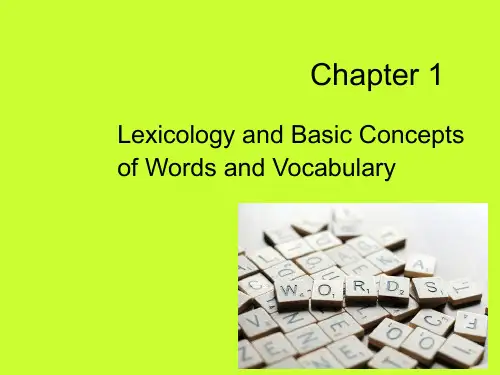
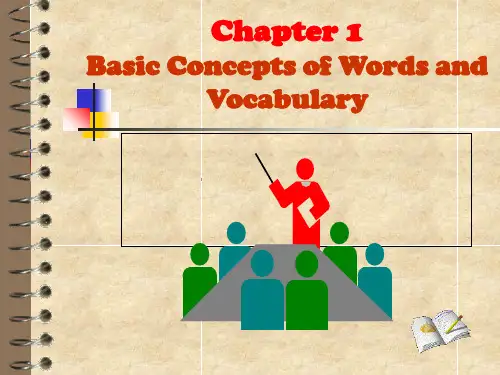
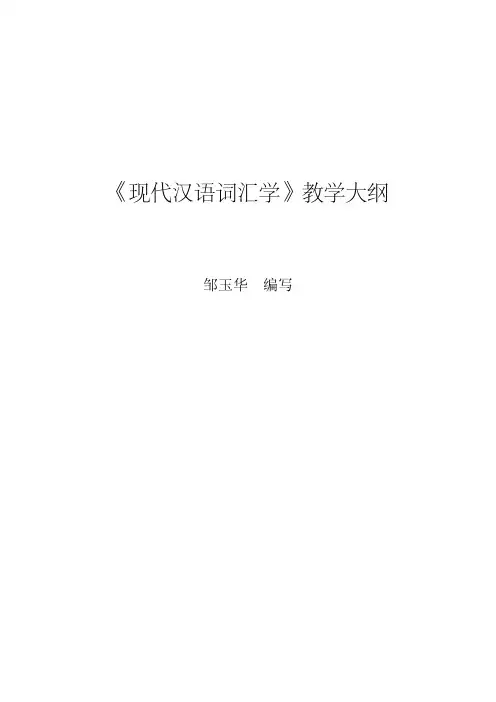

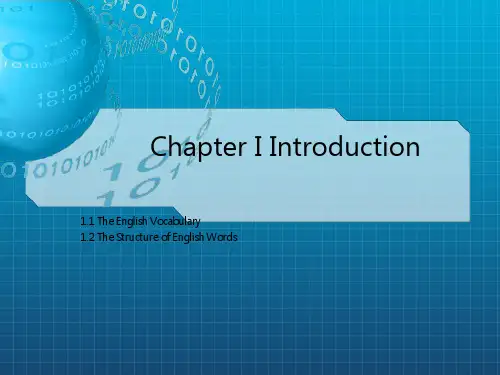
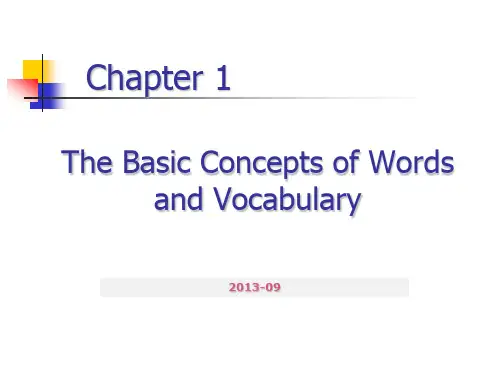
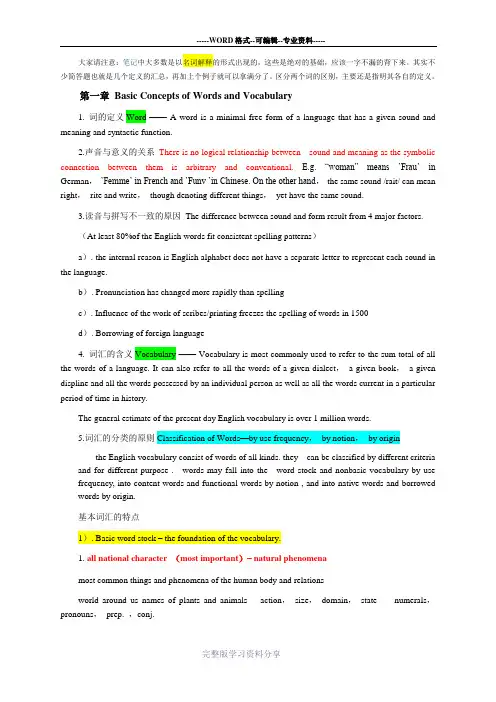
大家请注意:笔记中大多数是以名词解释的形式出现的,这些是绝对的基础,应该一字不漏的背下来。
其实不少简答题也就是几个定义的汇总,再加上个例子就可以拿满分了。
区分两个词的区别,主要还是指明其各自的定义。
第一章Basic Concepts of Words and Vocabulary1. 词的定义Word —— A word is a minimal free form of a language that has a given sound and meaning and syntactic function.2.声音与意义的关系There is no logical relationship between sound and meaning as the symbolic connection between them is arbitrary and conventional. E.g. “woman” means ’Frau’ in German,’Femme’ in French and ’Funv ’in Chinese. On the other hand,the same sound /rait/ can mean right,rite and write,though denoting different things,yet have the same sound.3.读音与拼写不一致的原因The difference between sound and form result from 4 major factors.(At least 80%of the English words fit consistent spelling patterns)a). the internal reason is English alphabet does not have a separate letter to represent each sound in the language.b). Pronunciation has changed more rapidly than spellingc). Influence of the work of scribes/printing freezes the spelling of words in 1500d). Borrowing of foreign language4. 词汇的含义Vocabulary —— Vocabulary is most commonly used to refer to the sum total of all the words of a language. It can also refer to all the words of a given dialect,a given book,a given displine and all the words possessed by an individual person as well as all the words current in a particular period of time in history.The general estimate of the present day English vocabulary is over 1 million words.5.词汇的分类的原则Classification of Words—by use frequency,by notion,by originthe English vocabulary consist of words of all kinds. they can be classified by different criteria and for different purpose . words may fall into the word stock and nonbasic vocabulary by use frequency, into content words and functional words by notion , and into native words and borrowed words by origin.基本词汇的特点1). Basic word stock – the foundation of the vocabulary.1.all national character (most important)– natural phenomenamost common things and phenomena of the human body and relationsworld around us names of plants and animals action,size,domain,state numerals,pronouns,prep. ,conj.2. stability– they donate the commonest thing necessary to life,they are like to remain unchanged. Only relative,some are undergoing some changes. But the change is slow.e.g. arrow,bow,chariot,knight – past electricity,machine,car,plane —— now3.productivity– they are mostly root words or monosyllabic words,they can form new words with other roots and affixes.e.g. foot – football,footage,footpath,footer4.polysemy – often possess more than one meaning. Become polysemous.e.g. take to move or carry from one place to another to remove5.collocability– quite a number of set expressions,idiomatic usages,proverbial saying and others基本词汇在英语中的地位和重要性The basic word stock is the foundation of the vocabulary accumulated over centuries and forms the common core of the language .though words of the basic word stock constitute a small percentage of the English vocabulary ,yet it is the most important part of it .e.g. heart – a change of heart, a heart of goldNon-basic vocabulary ——(例子)1. terminology – technical terms used in particular disciplines and academic areas as in medicinephotoscanning,hepatitis,indigestion,penicillin,algebra,trigonometry,calculus2. jargon– specialized vocabulary in certain professions.Bottom line,ballpark figures,bargaining chips,hold him back,hold him in,paranoid3. slang—— substandard words often used in informal occasionsdough and bread,grass and pot,beaver,smoky,bear,catch,holler,Roger,X-rays,Certain words are labeled slang because of their usage.4. argot – words used by sub-cultured groupscan-opener,dip,persuader cant,jargon ,argot are associated with,or most available to,specific groups of the population.5. dialectal words– only by speakers of the dialectbeauty,chook,cocky,station,auld,build,coo,hame,lough,bog6. archaisms – words no longer in common use or restricted in use. In older poems,legal document and religious writing or speech.7. neologism– newly created words with new meaning e.g. microelectronics,futurology,AIDS,internet,E-mailold meaning acquired new meaning e.g. mouse,monitor2). Content word (notional word)– denote clear notions.Functional word (empty word,form word)– do not have notions of their own,express the relation between notions,words and sentences.a. Content words constitute the main body of the English vocabulary are numerous.Functional words are in a small number.b. Content words are growing.Functional words remain stable.c. Functional words do far more work of expression than content words.3). Native words – are words brought to Britain in the 15 century by the German tribes. Ango-Saxon Words,50,000-60,000What is true of the basic word stock is also true of native world. More are1. neutral in style (not stylistical specific )2. 2.frequent in use (in academic fields and science French,Latin or Greek are used)(usage 70-90%)Borrowed words (loan words,borrowing)– words taken over from foreign language. 80%本族语词在英语中的地位和重要性Native words form the mainstream of the basic word stock and stand at the core of the language .therefore , what is true of the basic word stock is also true of native words.According to the degree of assimilation and manner of borrowing,we can bring the loan words under 4 classes.1.Denizen s– words borrowed early and now are well assimilated into English language.e.g. port from portus(L)shift,change,shirt,pork cup from cuppa(L)2.Aliens– retained their original pronunciation and spellinge.g. décor(F)blitzkreeg(G)emir,intermez,rowtow,bazaar,rajar,status quo3.translation loans– formed from the existing material in the English language but modeled on the patterns taken from another language.1). Word translated according to the meaninge.g. mother tough from lingua maternal(L)black humor from humor noir long time no see,surplus value,master piece2). Words translated according to the sounde.g. kulak from kyrak(Russ)lama from lama(Tib)ketchup tea4. Semantic loans– their meaning are borrowed from another languagee.g. stupid old dump new sassy dream old joy and peace pioneer old explorer/person doing pioneering work new a member of the young pioneer fresh old impertinent,sassy,cheeky 第二章The Development of the English1、Indo-European language family (Europe,the Near East,India)It can be grouped into an Eastern set :Balto –Slavic 、Indo-Iranian、Armenian and Albanian; a Western set: Celtic、Italic 、Hellenic、GermanicIn the Eastern set , Armenian and Albanian are each the only modern language respectively,the Balto –Slavic comprises such modern language such as Prussian、Lithuanian、Polish、Czech、Bulgarian、Slovenian、Russian. In the Indo-Iranian we have Persian, Bengali, Hindi, Romany, the last three of which are derived from the dead language Sanskrit.In the Western set, Greek is the modern language derived from Hellenic. In the Celtic,we find Scottish, Irish,Welsh, Breton. the five Romance language ,namely, Portuguese,Spanish, French, Italian, Roumanian all belong to the Italic through an intermediate language called Latin. The Germanic family consist of the four Northern European language :Norwegian, Icelandic, Danish and Swedish, which are generally known as Scandinavian languages. Then there is German, Dutch, Flemish and English.2、History (时间,历史事件,特征)1)Old English (450-1150)totally 50,000-60,000 wordsThe 1st people known to inhabit England were Celts,the language was Celtic.The second language was the Latin of the Roman Legions. The Germanic tribes called angles,Saxons and Jutes and their language,Anglo-Saxon dominated and blotted out the Celtic. Now people refer to Anglo-Saxon as old English. At the end of 6th century,the introduction of Christianity has a great impact on the English vocabulary. The common practice was to create new words by combining two native words. In the 9th century,many Scandinavian words came into English. At least 900 words of Scandinavian are in modern English,our daily life and speech.特点:highly inflected language///complex endings or vowel changes (full ending)2)Middle English (1150-1500)English,Latin,FrenchUntil 1066,although there were borrowings from Latin,the influence on English was mainly Germanic. But the Norman Conquest started a continual flow of French words into English.By the end of the 13th century,English gradually come back into public areas.Between 1250 and 150 about 9000 words of French origin pouered into English. 75% of them are till in use today.As many as 2500 words of Dutch origin come into English.特点:fewer inflections leveled ending3)Modern English (1500-up to now)early modern English (1500-1700)late modern English(1700-up to now)The Renaissance(the early period),Latin and Greek were recognized as the languages of the West ern world’s great literary heritage.From the 1500’s through the 1700’s ,many writers experimented with words. Over 10000 new words entered the English language .many of these were taken from Latin and Greek .The Industrial Revolution was in the mid-17 century. With the growth of colonization,British tentacles began a stretching out of to every corner of the globe,thus enabling English to absorb words from all major languages of the world.After World War II,many new words have been created to express new ideas,inventions and scientific achievements.More words are created by means of word-formation.thousands and thousands of new words have been entered to express new ideas inventions,and scientific achievements.more words are created by means of word-formation.in modern English,word endings were mostly lost with just a few exceptions English has evolved from a synthetic language to the present analytic language.science and technology terms make up about 45% of new words. words associated with life-style constitute of 24% and social and economic terms amount to over 10% .mention should be made of an opposite process of development i.e. old words falling out if use.特点:ending are almost lost.3. Three main sources new words当代英语词汇发展的现状New words sweep in at a rate much faster than at any other historical period of time .词汇发展的主要原因1).The rapid development of modern science and technology2).Social: economic and political changes3).The influence of other cultures and languages4. Three modes of vocabulary development(英语发展的三个主要方式:创造新词、旧词新意、借用外来语词)1. Creation – the formation of new words by using the existing materials,namely roots,affixes and other elements. (This is the most important way of vocabulary expansion.)2. Semantic change - an old form which take on a new meaning to meet the new need.3. Borrowing – to take in words from other languages.(played a vital role in the development of vocabulary , particularly in earlier times)4. (Reviving archaic or obsolete)French 30%,Latin 8%,Japanese Italian 7%,Spanish 6%,German Greek 5%,Russian Yiddish 4%第三章Word Formation*1. Morpheme(词素) ——A morpheme is the smallest meaningful unit of a language. (The smallest functional unit in the composition of words.)*2.Morph——A morpheme must be realized by discrete units. These actual spoken minimal carriers of meaning are morphs.3.Monomorphenic words– morphemes are realized by single morphs.4.Allomorph(词素变体)——Some morphemes are realized by more than one morph according to their position. Such alternative morphs are allomorphemes. E.g. the morpheme of plurality (-s)has a number if allomorphemes in different sound context,e.g. in cats/s/,in bags/z/,in matches/iz/.5. Free morphemes or Free root —— The morphemes have complete meaning and van be used as free grammatical units in sentences,e.g. cat,walk. They are identical with root words. morphemes which are independent of other morphemes are considered to be free.6.Bound Morphemes——The morphemes cannot occur as separate words. They are bound to other morphemes to form words,e.g. recollection (re+collect+ion)collect – free morpheme re-and –ion are bound morphemes. (include bound root and affix)Bound morphemes are found in derived words.7.Bound root —— A bound root is that part of the word that carries the fundamental meaning just like a free root. Unlike a free root,it is a bound form and has to combine with other morphemes to make words. Take -dict- for example:it conveys the meaning of “say or speak” as a Latin root,but not as a word. With the prefix pre-(=before)we obtain the verb predict meaning “tell beforehand”。
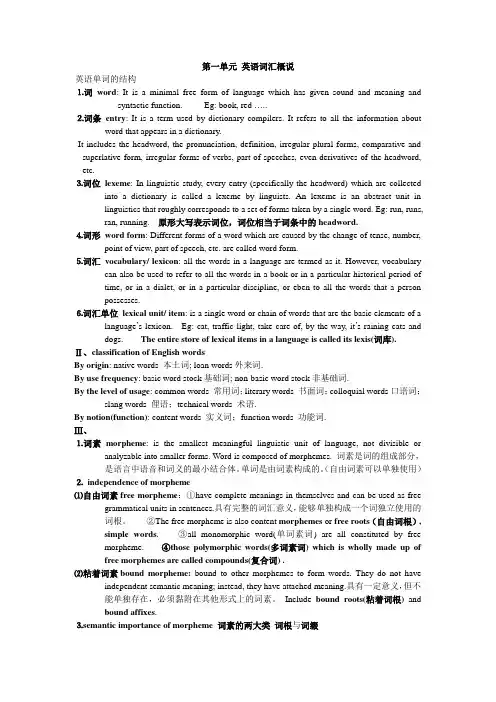
第一单元英语词汇概说英语单词的结构⒈词word: It is a minimal free form of language which has given sound and meaning andsyntactic function. Eg: book, red …..⒉词条entry: It is a term used by dictionary compilers. It refers to all the information aboutword that appears in a dictionary.It includes the headword, the pronunciation, definition, irregular plural forms, comparative and superlative form, irregular forms of verbs, part of speeches, even derivatives of the headword, etc.⒊词位lexeme: In linguistic study, every entry (specifically the headword) which are collectedinto a dictionary is called a lexeme by linguists. An lexeme is an abstract unit in linguistics that roughly corresponds to a set of forms taken by a single word. Eg: run, runs, ran, running. 原形大写表示词位,词位相当于词条中的headword.⒋词形word form: Different forms of a word which are caused by the change of tense, number,point of view, part of speech, etc. are called word form.⒌词汇vocabulary/ lexicon: all the words in a language are termed as it. However, vocabularycan also be used to refer to all the words in a book or in a particular historical period of time, or in a dialet, or in a particular discipline, or eben to all the words that a person possesses.⒍词汇单位lexical unit/ item: is a single word or chain of words that are the basic elements of alanguage’s lexicon. Eg: cat, traffic light, take care of, by-the-way, it’s raining cats and dogs. The entire store of lexical items in a language is called its lexis(词库).Ⅱ、classification of English wordsBy origin: native words 本土词; loan words外来词.By use frequency: basic word stock基础词; non-basic word stock非基础词.By the level of usage: common words 常用词;literary words 书面词;colloquial words口语词;slang words 俚语;technical words 术语.By notion(function): content words 实义词;function words 功能词.Ⅲ、⒈词素morpheme: is the smallest meaningful linguistic unit of language, not divisible oranalyzable into smaller forms. Word is composed of morphemes. 词素是词的组成部分,是语言中语音和词义的最小结合体。
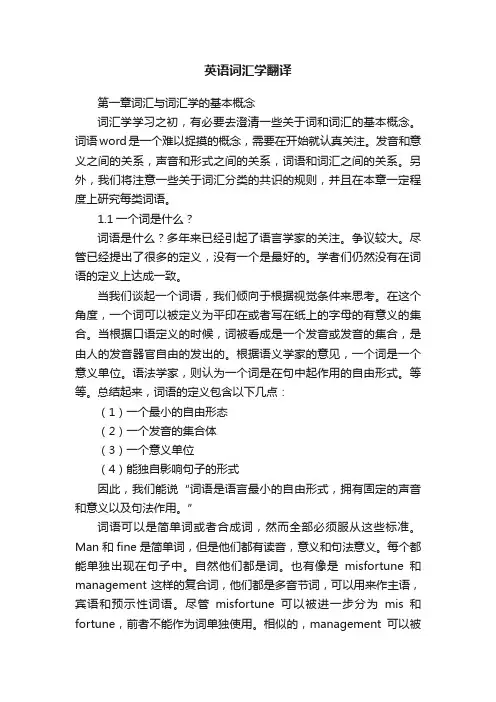
英语词汇学翻译第一章词汇与词汇学的基本概念词汇学学习之初,有必要去澄清一些关于词和词汇的基本概念。
词语word是一个难以捉摸的概念,需要在开始就认真关注。
发音和意义之间的关系,声音和形式之间的关系,词语和词汇之间的关系。
另外,我们将注意一些关于词汇分类的共识的规则,并且在本章一定程度上研究每类词语。
1.1一个词是什么?词语是什么?多年来已经引起了语言学家的关注。
争议较大。
尽管已经提出了很多的定义,没有一个是最好的。
学者们仍然没有在词语的定义上达成一致。
当我们谈起一个词语,我们倾向于根据视觉条件来思考。
在这个角度,一个词可以被定义为平印在或者写在纸上的字母的有意义的集合。
当根据口语定义的时候,词被看成是一个发音或发音的集合,是由人的发音器官自由的发出的。
根据语义学家的意见,一个词是一个意义单位。
语法学家,则认为一个词是在句中起作用的自由形式。
等等。
总结起来,词语的定义包含以下几点:(1)一个最小的自由形态(2)一个发音的集合体(3)一个意义单位(4)能独自影响句子的形式因此,我们能说“词语是语言最小的自由形式,拥有固定的声音和意义以及句法作用。
”词语可以是简单词或者合成词,然而全部必须服从这些标准。
Man和fine是简单词,但是他们都有读音,意义和句法意义。
每个都能单独出现在句子中。
自然他们都是词。
也有像是misfortune和management这样的复合词,他们都是多音节词,可以用来作主语,宾语和预示性词语。
尽管misfortune可以被进一步分为mis和fortune,前者不能作为词单独使用。
相似的,management可以被分成manage和ment,但是后者不能自由使用。
Blackmail能被分为black和mail,而且都能作为独立的句子单位使用,然而词的意思绝对不是两个部分的组合。
Black是颜色,针对white,mail指示“被邮局运送的东西”,然而当它们放在一起,组合形式意味着“强迫,利用不光彩的秘密要人送钱或行动作为答复。
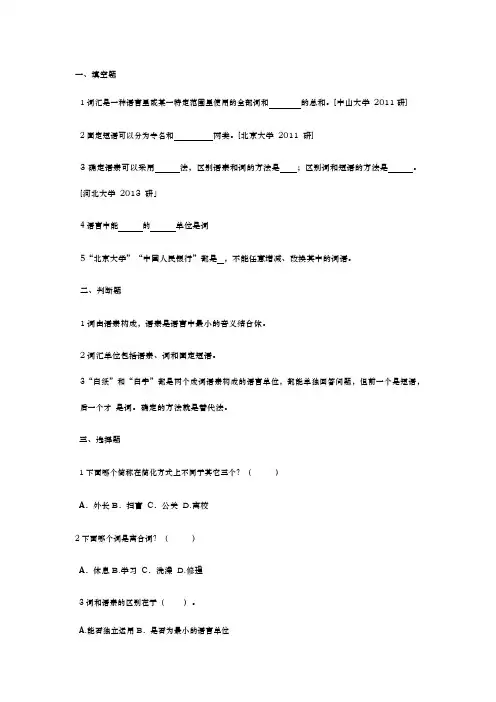
一、填空题1词汇是一种语言里或某一特定范围里使用的全部词和的总和。
[中山大学2011研]2固定短语可以分为专名和两类。
[北京大学2011 研]3确定语素可以采用法,区别语素和词的方法是;区别词和短语的方法是。
[河北大学2013 研」4语言中能的单位是词5“北京大学”“中国人民银行”都是,不能任意增减、改换其中的词语。
二、判断题1词由语素构成,语素是语言中最小的音义结合体。
2词汇单位包括语素、词和固定短语。
3“白纸”和“白字”都是两个成词语素构成的语言单位,都能单独回答问题,但前一个是短语,后一个才是词。
确定的方法就是替代法。
三、选择题1下面哪个简称在简化方式上不同于其它三个?()A.外长B.扫盲C.公关D.离校2下面哪个词是离合词?()A.休息B.学习C.洗澡D.修理3词和语素的区别在于()。
A.能否独立运用B.是否为最小的语言单位C.是否为最小的造句单位D.是否为最小的能够独立运用的单位4“旮旯”()。
A.不是词C.不是语素B.由一个语素构成词D.由两个语素构成词5“尴”是一个。
A.语素B.词C.音节D.短语6“坐”是一个。
A.语素B.词C.短语D.句子7下面各组词语,全是词的一组是。
A.看玻花电视B.丢蓝牛白纸C.了打向白字D.倒成尴提高8下列各项中是词的有。
A.白纸B.耳朵软C.新房D.欠债E.没说的四、名词解释固定短语五、分析题1“不小心丢了一卷绷带、一束花儿”中有几个音节?几个语素?几个词?2外国留学生学习汉语时常出现这样一类错误:“我今天见面了我的朋友、我应该鞠躬老师”,请分析此类错误的原因。
(10分)3我们平时去菜场买菜,如果问“这是什么肉”,回答只能是“牛肉”、“羊肉”或“猪肉”,而不能说“牛的肉”,为什么?“牛肉”和“牛的肉”有什么区别?五、简答题1.什么是缩略语?举例说明其类型及各类型的形成方式。
(15分)2.缩略语的类型和缩略方式有哪些?(10分)3.运用“扩展检测法”区别下列语言单位哪些是单词,哪些是短语。
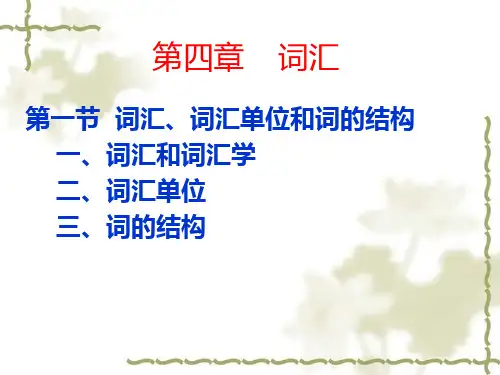
Chapter 3 Morphology structure of English words3.1 MorphemesThe definition of a morpheme : The morpheme(词素) is the smallest meaningful linguistic unit of language, not divisible or analyzable into smaller forms. A word is the smallest unit of a language that stands alone to communicate meaning. Structurally, however, a word is not the smallest unit because many words can be separated into smaller meaningful units. Words are composed of morphemes. What is usually considered a single word in English may be composed of one or more morphemesWords can have an internal structure, i.e. they are decomposable into smaller meaningful parts. These smallest meaningful units we call morphemes.One morpheme: nationTwo morphemes: nation-alThree morphemes: nation-al-izeFour morphemes: de-nation-al-ize确定语素必须满足两个标准, 一是含义相近, 二是发音相近.-ly 在 manly, princely, friendly 中属于同一个语素.-er 在 worker, teacher, speaker, swimmer 等词中意为"做…的人", 属于同一语素,但在 manner 一词并不是 man 和 -er 合起来的意思, 所以 manner 不能看作是由 man 和 -er 两个语素构成, 其中的 -er 也不能看作是与 worker 中的 -er 相同的语素.3.2 Classification of MorphemesMorphemes can be classified in various ways.Morphemes may be classified into free and bound. Free morphemes (自由词素), also called content morphemes(实义词素), may constitute words by themselves. Bound morphemes (粘着词素), known as grammatical morphemes (语法词素), must appear with at least one other morpheme, either free or bound.3.2.1 Types of Morphemes —free vs. bound● Free morphemes(自由词素)Morphemes which are independent of other morphemes are considered to be free. Free morphemes have complete meanings in themselves and can be used as free grammatical units in sentences. Therefore, we might as well say that free morphemes are content morphemes (实义词素)or free roots(自由词根).man, earth, wind, faith, red, write ….● Bound Morphemes(粘着词素)Morphemes which cannot occur as separate words are bound. They are so named because they are bound to other morphemes to form words. Unlike free morphemes, they do not have independent semantic meaning; instead, they have attached meaning (un-kind, hope-ful) or grammatical meaning (cat-s, slow-ly, walk-ing, call-ed). They are also called grammatical morphemes.3.2.2 types of morphemes —root vs. affixesMorphemes may also be classified into roots (or root morphemes) and affixes (or affixational morphemes). definition of root :A root is the part of the word-form which remains when all the affixes have been removed.A root is the basic unchangeable part of a word which conveys the fundamental meaning of the word.Two types of roots – Free roots: Morphemes are said to be free if they can stand alone as words (In English,many roots are free roots) black in black, blackboard, blacksmith, blackmail.Bound roots: They are so called because they are always bound to something else. Theycannot exist on their own ceive in receive, perceive, conceive, deceive. Bound roots(粘着词根): A bound root is that part of the word that carries the fundamental meaning just like a free root. Unlike a free root, it is a bound form and has to combine with other morphemes to make words.(However, there are quite a number of roots which cannot exist on their own and thus belong to the class of bound morphemes.For example, ceive in receive, conceive, perceive, deceive. these roots cannot be used to form new words.) A root, whether it is free or bound, generally carries the main component of meaning in a word.therefore, that a knowledge of roots can help one to analyze and understand many words almost on sight. Although the Latin and Greek roots are usually bound morphemes and cannot stand alone, it is helpful to free boundroot affix inflectional derivationalrecognize some of the common ones, since thousands of English words are built on them. Knowing the meaning of these roots can help clarify the meaning of many English words.3.2.3 Two types of affixesAffixes(词缀): Affixes are forms that are attached to words or word elements to modify meaning or function. According to the functions of affixes, we can put them into two groups: inflectional (曲折词缀)and derivational (派生词缀)affixes.Affixes can be divided into inflectional morphemes and derivational morphemes. This reflects two major morphological (word building) processes:Affix is a collective term for the type of formative (构词成分) that can be used only when added to another morpheme.●Inflectional affixes: does not form a new meaning when it is added to another word. Nor does it change thepart of the word to which it is affixed.●Derivational affixes: when they are added to another morpheme, they derive a new word.Many have a specific lexical meaning. Quite a number of them have more than one meaning. They have affective meaning3.2.3 affixes●Inflectional affixes(曲折词缀)Affixes attached to the end of words to indicate grammatical relationships are inflectional, thus known as inflectional morphemes. For example: cats, walked, walking, John’s book…●Derivational affixes(派生词缀)Affixes added to other morphemes to create new words. They can be further divided into prefixes and suffixes Prefixes(前缀) ; Suffixes(后缀)Inflectional affixes (or inflectional morphemes) serve to express the following meanings:(1) plurality: e.g. -s in chairs, pens; -es in boxes, tomatoes; en in oxen.(2) the genitive case: e.g. ’s in boy’s, children’s.(3) the verbal endings: for example,a. -(e)s in words like eats, teaches shows the third person singular present tense.b. -ing in words like eating, teaching shows the present participle or gerund.c. -(e)d in words like worked, saved shows the past tense or past participle.(4) the comparative and superlative degrees:e.g. -er in words like smaller, harder; -est in words like smallest, hardest.●Derivational Morphemes-- either by changing the meaning of the base to which they are attached; or by changing the grammatical category (part of speech) of the baseDerivational Affixes are subdivided into prefixes and suffixes(1) Prefixes are affixes before the root, e.g. unjust, rewrite.As a rule, most prefixes modify the meaning of roots, but not their parts of speech.task: list some prefixes that can modify the parts of speech. - en-(em-) as in words like embody, enrich (2) Suffixes are affixes after the root, e.g. darkness, worker.By the addition of the suffix, the word is usually changed from one part of speech into another, e.g. liberation, modernizeBoth prefixes and suffixes may be grouped according to:1. Their linguistic origin: Native/foreign affixes1). Native affixes are those that existed in the OE period or were formed from OE words, such as un-, mis-,be-,out-, over-, -ness, -dom, -hood, -ly, and –er.2). Foreign affixes came as a part of loan words from Latin, Greek, French, or other languages. Examples:ab-(L), bi-(L), dis-(L), re-(L), kilo-(Gk), poly-(Gk), mal-(F), -ic(Gk), -ism(Gk), -ist(Gk), -able (F), and –ize(F).A hybrid混合词is a word made up of elements from two or more different languages.2. Their productivity: Affixes (such as re-, un-, -able, -ize) are called productive or living when they can be used to form new words.Those that are no longer used to form new words are termed dead or unproductive.Examples of dead affixes are: for- as in forget, forgive and forbid; with- as in withdraw, withhold and withstand,and –ant or –ent as in servant, different, etc.Sum: Inflection and DerivationDerivational morphemes are used to create new lexical items (lexemes (词位)).Inflectional morphemes only contribute to the inflectional paradigm 词形变化 of the lexemes, which lists all the word-forms of the lexeme.3.2 Types of MorphemesDiagram of morphemesclassification of words on a morphemic levelOn this level, words, according to the number and type of morphemes they contain, can be classified into:(1) simple words: those consisting of a single morpheme, such as man, work, kind;(2) derived words: those which are the result of a derivational process. Such words usually consist of a free morpheme and one (or more than one) bound morpheme, such as fruitless, fruitful, unfruitful, unfruitfulness;(3) compound words: those which are composed of two or more free morphemes, e.g. deep structure, spacesuit, forget-me-not, stick-in-the-mud, and jack of all trades.3.3 Morph and allomorphThe definition of morph(语素形式/词素形式)- phonological (音韵的)and orthographical (拼写的)forms used to represent morphemes. Morphemes can be represented in braces. For example, {big} is pronounced as /big/ and spelled as big, thus /big/ and big are respectively the phonological and orthographical morphs of {big} .Morpheme, Morph, AllomorphA morph is a physical form representing a certain morpheme in a language.Sometimes different morphs may represent the same morpheme; i.e., a morpheme may take different forms. If so, they are called allomorphs of that morpheme.An allomorph(词素变体) is any of the variant forms of a morpheme as conditioned by position or adjoining sounds.区别:语言中最小的不可再分的意义单位是词素morpheme(又可称为形位、语素等)。
2012级(1)班Chaper1 The Basic Concepts Of Words and Vocabularyof the statements below is followed by four alternative answers. Choose the one that would best complete the statement.1. ______is the most important of all characteristics of the basic word stock. Stability national character2. Nonbasic vocabulary includes all of the following except_______ .words3. According to the origins of the words, English words can be classified into _______ .words and functional words words and borrowed wordswords and dialectal words words and dialectal words4. Borrowings can be divided into________., semantic loans, translationloans, denizenswords, notional words, form words, content words, portmanteau words, acronyms, initializes, compounds, converted words and clipped words5. Apart from the characteristics of basic vocabulary, native words have two other features, namely_________.and stability in style and high frequency in useand polysemy and arbitrariness6.The word beaver(meaning“girl”)is_______ .dialectal word archaism7. AIDS as a nonbasic word is_______ .archaismwords include the following word classes except_______ .9. Vocabulary can refer to the following except_______ .total number of the words in alanguagethe words used in a particular historical periodthe words of a given dialectwords a person knowsis a loan word from_______ .11. _______ form the mainstream of the basic word stock.words B. Frenchwords words wordshumor is_______ .translation loan semantic loan denizen alienand numerals are semantically_______ and have limited_______ .;use and stability ;collocability and stability;use and productivity ;productivity andcollectabilityis_______ .archaism,words fall into functional words and content words.frequency formation16. The symbolic connection between sound and meaning is almost always_______ .17. _______ are loan words that have become assimilated in English.A.Denizens loans loans, which means “police”,is a(n) _______ word.19. Wherein which means “in what”is a(n)word. _______difference between sound and form due to all the following except _______. phonemes than lettersB. stabilization of spelling by printingof spelling by early scribesof pronunciationthe following statements with proper words or expressions according to the course book1. Lexicology is a branch of linguisticsstudying the origins and_______ of words .2. A word is a minimal free form of language that has a given sound, meaning and_______ function.3. In spite of the differences between sound and form,at least_______ percent of the English words fit consistent spelling patternsthe words in language make up its_______ .word stock is the foundations of the vocabulary accumulated over centuries and form the common core of the language.,begin is a native word.7. _______ vocabulary include cant,jargon and argot.8. There is no_______ relationship between the sound which stands for a thing or an idea and the actual thing and idea itself.9. _______ are the basic units of sentences.10. Early borrowings are mostly_______ whereas later loan words remain foreign in sound and spelling.whether the following statements are true or false( ) word can be defined in different ways from different points of view.( ) no circumstances can sound and meaning be intrinsically related.( ) introduction of printing press resulted in a lot more differences between sound and form.( ) words a person can use in speaking and writing form his active vocabulary. ( ) principles by which to classify words are usage, notion and origin.( ) words are more popular than foreign words.( ) words enjoy the same features as the basic word stock and more.( )(meaning “old”)is an instance of archaism.( ) a loan word known as an alien.( ) time no see is a case of translation loan.a term for each of the following definitions.1.Sub-standard words often used on informal occasions.( )2.Specialized vocabulary common in certain professions.( )3.Words used by sub-culturegroups, particularly by understood society.( )4.Words that have clear notions.( )5.Words of Anglo-Saxon origin.( )6.Words borrowed by way of translation. ( )7.Old words with new meanings.( )8.Words which have become assimilated.( )9.Native forms whose meanings are borrowed.( )10.Words essential to native speakers’ daily communication.( )the following questions .Your answers should be clear and short.1.What is the relationship between sound and meaning2.Why are there so many differences between sound and form3.What are the criteria for classification of words4.What are the characteristics of the basic word and word stock[Answers](eighty) 10assimilated2. Fwords words loans loan word stockV.1.The relationship is almost always arbitrary and conventional ana there is nological connection between sound and meaning.2.There are four major reasons.(1)The internal reason:the English alphabet wasadopted from the Romans,which have more phonemes than letters,so there is nota separate letter to represent each sound.(2)Pronunciation has changed morerapidly than spelling.(3)The spelling forms were changed by the early scribes to make theeir writing more recognizable.(4)Borrowing.3.There are mainly there criteria for may fall into:the basic word stock andnonbasic vocabulary by use frequency;content words and functional words by notion;native words and borrowed words by prigin.4.The basic word stock has five charecteristic:(1)all nationalcharacter,(2)stability,(3)productivi-ty,(4)polysemy,(5)productivity.Chapter2 The Development Of the English Vocabularyof the statements below is followed by four alternative answers. Choose the one that would best complete the statement.1.It is assumed that the world has 3000 languages, which can be grouped intoroughly_______ language families on the basis of similarities in their basic word stock and grammar.2. The following languages all belong to the Eastern set except_______ .3. In the Eastern set,Armenian and_______ are the sole modern languages in the two respective families.language does not belong to the Italic.early inhabitants of the British Isles spoke_______ .Germanic speakers took permanent control of the land that was later called_______ (the land of Angles).English has a vocabulary of about 50000 to 60000 words,which is entirely Germanic with only a few borrowings from_______ and Scandinavian.influx of French words into English did not occur until after_______ .the Middle English period,the three main dialects of the land were Northern, _______ and Midland.10. _______ is the chief ancestor of Modern English,not Southern.Norman Conquest started a continual flow of_______ words into English.is an_______ dialect,as its name implies, and intelligible to Northerner and Southerners alike.number of_______ words that poured into English was unbelievably great and covered every realm of culture and society in the Middle English period.English regained social status in Middle English period,those imposer spoke French;those who were literate read and wrote _______ ;those who could educate their children taught them in _______ ;and any young man who sought to earn his living as a scribe learned_______ or_______ .;French;Latin;French ;French;French;English;French;Latin;French ;French;Greek;Frenchthe early period of modern English,Europe saw a new upsurge in learning ancient Greek and Roman classic,which is known in history as the_______ .the beginning of the 20th century, particularly after World War II,although borrowing remains channel of English vocabulary expansion,more words are created by_______ .Anglo-Saxon in the Old English period was almost a “_______ ”language,which created new words from its own compound elements with few foreign words.one scholar notes,old English was characterized by “_______ endings”,MiddleEnglish by “leveled endings”,and Modern English by “_______ endings”.;lost ;full ;pure ;lostEnglish which was a_______ language has evolved to the present_______ language.;synthetic ;analytic;analytic ;syntheticall the foreign languages from which we have borrowed words,Latin ,Greek,French,and_______ stand out as the major contributors.the Pre-Anglo-Saxon period,the words borrowed naturally from reflected the new experience in_______ and _______ .;economy ;agriculture ;shrinethe Old English period,borrowings from Latin came in because of the introduction of Christianity,such as, _______ and _______ .;candle ;sack ;shrine ;circlecenturies were especially prolific in Latin borrowingsunder the influence of Renaissance.and 13th and 14th and15th and 16thlate borrowings from Latin still retain their Latin of the following was borrowed in the Modern English periodB . Focusof the following does not come from Greekis from_______ and tatami is from_______ .;African ;Japanese ;Turkish ;JapaneseEnglish vocabulary develops through_______ .,analogyand ,semantic and borrowing,archaisms,and semantic change,denizens and argotof the following contemporary English vocabulary is from the rapid growth of science and technologysuit belt jacketsScandinavian languages:Norwegian,Swedish,Danish,and Icelandic,constitute the_______ branch of the Germanic group.archaic or_______ words also contributes to the growth of English vocabulary though insignificant.II.Decide whether the following statements are true or false.( ) is more closed related to German than French.( ) languages refer to Icelandic,Norwegian,Danish,and Swedish( ) English was a highly infected language.( ) early Middle English period,English,Latin,and Celtic existed side by side. ( ) introduction of printing into England marked the beginning of Modern English period.( ) English is considered to be an analytic language.( ) four major foreign contributors to English vocabulary in earlier times are Latin,French,Scandinavian and Italian.( ) modern times,borrowing brings less than percent of modern English vocabulary. ( ) three major factors that promote the growth of modern English vocabulary are advances in science and technology,influence of foreign cultures and languages. ( ) most important mode of vocabulary development in present-day English is creation of new words by means of word-formation.( ) English vocabulary was in essence Germanic with a small quantity of words borrowed from Latin and Scandinavian.( ) English absorbed a tremendous number of foreign words but with little change in word endings.the following terms.1.the Indo-European Language Family2.Old English3.foreign elements4.creation5.semantic changefollowing answers should be clear and short1.Why did Middle become the chief ancestor of Modern English2.What are the characteristics of Modern English3.What are the reasons for the growth of contemporary English vocabulary4.What are the general characteristics of the world-wide appeal of Englishand comment on the following.1.Soft drinks and minerals sold here.Tell what“soft drink” and “mineral” mean respectively and explain why they take on those meanings in modern American English.2.“Moon”was originally written as “moan”and the pronuncia tions of the twowords are different,too .Explain the reasons for the change in spelling and pronunciation.AnswersI.II.III.1.The Indo-European Language Family is made up of most languages of Europe,theNear East,and to the geographical distribution,these languages fall into ten principal groups,belonging to two sets,namely an Eastern set and a Western Eastern set consists of:Balto-Slavic,Indo-Iranian,AmericanandAlbanian; the Western set comprises:Celtic,Italic, Hellenic, Germanic, Hittite and Tocharian.2.Old English grew out of the Anglo-Saxon,which has a vocabulary of about 50000to 60000 vocabulary is almost monogamous and entirely Geomantic with only a few borrowings from Latin and Scandinavian.3.English vocabulary owes most of its words to foreign words borrowed from otherlanguages are known as foreign elements in the English vocabulary.4.Creation refers to the formation of new words by using the existingmaterials,namely roots,affixes and other modern times,this is the most important way of vocabularyexpansion.5.Semantic change refers to an old form whichtakes on a new meaning to meet thenew does not increase the number of word forms but create many new usage of the existing words.IV.1. There are several reasons:(1)The midland included London,which was then the capital of England,naturally the political,economical and cultural center.(2)Two great writers Wycliffe and Chaucer employed the Midland dialect in their writings.(3)Midland is an intermediate dialect,as its name implies,and intelligible to Northerners and Southerners alike,whereas these speakers could not often understand each other using their own dialects respectively.(4)When Caxton introduced the printing press in 1477, the printerspatronized the Midland dialect, and any English man who wanted to be published had to write in that dialect.2. Modern English has a huge vocabulary of different elements. Most of the words have actually been borrowed from other languages. Word endings are mostly lost with just a few exceptions.3. Generally there are three main sources of new words:the rapid development of modern science and technology;social,economic and political changes;the influenceof other cultures and languages.4. The more obvious and striking features are summed up as follows:(1)receptivity, adaptability and heterogeneity;(2)simplicity of inflection(3)relatively fixed word-order.V.1.(1) “soft drink” means “carbonated drinks” and “mineral” means “mineralwater” in present American English.(2)“soft drink” means “non-alcoholic beverage” and “mineral” means “ore”in British English, but these words no longer have such meanings in present British English.(3) American English has revived the old meaning of “soft drink” and that of“mineral”. This is because it is easy to understand and remember.2. (1) “Mona” is an early borrowed word but the original form did not conform to the English way of pronunciation and spelling.(2) In later development, the word became well assimilated into English languages.(3) At present “mona”is written as “moon”, conforming to the English way of pronunciation and spelling.。
葛本仪的《现代汉语词汇学》第一章对词汇的再认识第一节词汇的内容一、词汇的界定及其性质词汇是一种语言中所有的词和所有的相当于词的作用的固定结构的总汇。
二、词汇的内容和范围(一)词的总汇1.基本词汇特点:①普遍性②稳固性③产生新词的基础基本词成为产生新词的基础,主要体现在两个方面,一方面是构成单纯基本词的词素,如“人”作为词素构成了“人”这一基本词,同时“人”作为词素又可以参与构成许多其他的合成词,从而形成它的能产性;另一方面是由合成词充当的基本词,当它被社会广泛使用并具有一定的稳固性之后,它就会以整体的形式转化成为合成词素,并参与创制新词。
稳固性不能和历史悠久完全等同起来,因为许多非基本词也同样可以具有历史悠久的特点。
但是一个具有悠久历史的词如果没有普遍性仍不可能成为基本词,同样一个并非具有悠久历史的词,但它某个历史发展阶段内具有普遍性,并进而形成了它的稳固性,那么它也有可能进入到基本词汇中来。
2.一般词汇①历史上承传下来的固有词②适应社会需要而产生的新词③因特殊需要而加以运用的古语词④从方言中吸收来的方言词⑤受外族语影响而产生的外来词(1)音译词——直接模仿外语词的语音形式,再用汉语语音加以改造,使它符合汉语语音的特点和规则,从而产生新词。
(2)形兼音译词——书面上直接借用外语字母的形式,再将其读音用汉语语音加以改造,使其符合汉语语音的特点和规则,从而形成为汉语的外来词。
(3)音加意译词——把已经汉化了的音译成分和原外语词的意义有关的汉语词素相组合,从而形成新的外来词。
(4)形加意译词——把直接借用的代表汉语词的字母形式,用汉语语音加以汉化后,再和有关的汉语词素相组合,从而产生新的外来词。
(5)音意兼译词——在外语词汉语语音化的基础上,巧妙地把一个音节用汉语的与之语音相近意义相关的汉字来表示,这些汉字从形式上看很像组成该词的汉语词素。
(6)意译词——在外语词的基础上,借鉴其意义,然后用汉语的词素和组词规则形成新词。
葛本仪:《现代汉语词汇学》读书笔记第一章对词汇的再认识第一节词汇的内容一、词汇的界定及其性质1.“词汇”是一个指称词的集体的概念,是表示词的总和的意义的。
我们在一些著述中能够经常见到一些解释,如:“语言中所有的词构成所谓语言的词汇”(斯大林语),“一部书中所用的词的总和就叫做词汇”,或者说不论在什么情况下,“词的总称就叫做词汇”等等。
在日常交际中,在某种语境下,这样的解释是完全正确的。
但是从语言研究的角度来考虑,用词汇学的科学术语的含义来要求,这种解释显然就不够严格和正确了。
要给词汇作出正确的界定,还必须从词汇的性质谈起。
2.词汇的性质:早在50年代,斯大林就已经指出:“拿词汇本身来说,它还不是语言,——它好比是语言的建筑材料。
建筑业中的建筑材料并不就是房屋,虽然没有建筑材料就不可能建成房屋。
同样,语言的词汇也不就是语言,虽然没有词汇,任何语言都是不可想象的。
但是当语言的词汇受着语言语法的支配的时候就会获得极大的意义。
”斯大林这段话今天看来,尽管有许多不完善的地方,但是它总也提出了词汇的基本性质和作用。
在语言中,应该说,作为语言的建筑材料的成分很多,这就要看是在什么范围内,什么条件下,充当什么样的建筑材料等问题。
例如形成为音位的音素只能是音节的建筑材料,词素只能是词的建筑材料等。
对于词汇来说,它作为建筑材料,其作用是为了构成句子,也就是说词汇作为建筑材料,就是用来组成言语以进行交际的,因此,作为造句的材料就是词汇的功能和性质。
根据词汇的这一特点,应该承认,凡是具有这种功能和性质的语言成分,都应该属于词汇的范围之内,例如成语、惯用语等等,因为它们虽然都是由词组成的词组形式,但是它们却都是一种组句的备用单位,都具有和词一样的建筑材料的性质和作用,语言词汇当然不应该而且也不能够把这类成分排斥在词汇之外。
因此我们认为,词汇应当是一种语言中所有的词和所有的相当于词的作用的固定结构的总汇。
所以,任何种语言的词汇都包括着两个基本的内容:①该语言中所有的词的总汇②所有的相当于词的作用的固定结构的总汇。